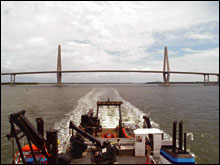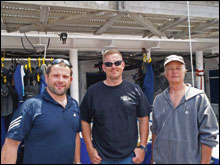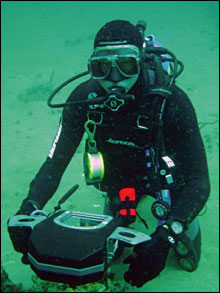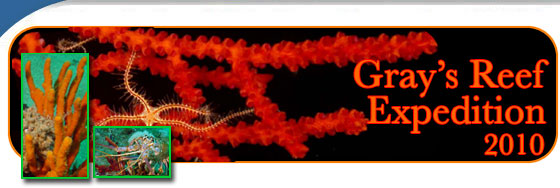Error processing SSI file
|
Gray's Reef Expedition
Log Day 8: May 24, 2010
Randy Rudd
Team Ocean Volunteer Science Diver
 |
| Leaving Charleston, S.C. harbor. (Photo: Randy Rudd/Team Ocean Volunteer)
|
It is May 24, 2010. I have been aboard the NOAA Research Ship Nancy Foster since May 16, 2010. I am a Volunteer NOAA Science Diver, with Team Ocean, based at Gray's Reef National Marine Sanctuary in Savannah, Georgia. My job is to assist the scientists on this cruise with the research that is being conducted within the marine sanctuary.
I have one of the best 'jobs' on the ship. I love to dive, and the scientists need diving assistants. I get to dive as many as 4 dives per day. The crew lifts our boats of the deck and places them in the water. We get in and head for a dive site. Shortly, I am 60 plus feet underwater assisting in a variety of underwater activities. What more could a diver ask for.
 |
| Team Ocean Members From Left, Keith Borden, Shannon McAteer, Randy Rudd. (Photo: Greg McFall/Gray's Reef National Marine Sanctuary Volunteer)
|
Everyone on the science team 'pitches in' with the work load. In addition to diving, I also do other tasks. I tend to gear on the Zodiac I dive from. I refill scuba tanks, which keeps us all diving. When it comes to getting the work done, everyone helps out.
My primary diving mission has been to assist a marine biologist, graduate student, with habitat studies, fish counts, invertebrate counts, and characterizing the ledges and undercuts the are a part of the Sanctuary. This has allowed me to dive in a variety of locations within the Sanctuary.
 |
| Randy tracking acoustically tagged fish. (Photo: Srah Fangman/Gray's Reef National Marine Sanctuary Volunteer)
|
When you spend as much time in the water as we do, you are bound to see some truly amazing things and have some amazing experiences. I had heard that the Sanctuary had a resident Tiger Shark. C.J. Carroll, my dive partner and Marine Biologist, and I have now seen the Tiger shark on two different occasions. On our 2nd encounter, May 23, 2010, the shark came quite close, allowing us to determine that it is a female, 10 to 12 feet in length. She was quite curious about us. Without a doubt, an encounter like this, with such a magnificent animal, leaves your heart pounding. While I was on a later dive that day, on a different boat, in a different location, the Chief Scientist, Sarah Fangman, and another Team Ocean Volunteer, Keith Borden, were also able to see this shark.
When all the days' dives were completed, tanks filled, tasks completed, I took some time to go to the bow of the ship to enjoy the view and reflect on the excitement of the day. Again, I was treated to one of those rare and fun sights. Three spotted dolphins appeared. They were jumping and swimming in the pressure wave of the ship's bow. They would play, then leave, then return. This went on for 30 minutes or more. It was a fine end to an exciting day.
Finally, I have to say that none of the scientific work happening here would be possible without the crew of this ship. They are truly wonderful. Their skill, assistance, and support, make it all possible. They get the least credit, yet put out maximum effort.
|








